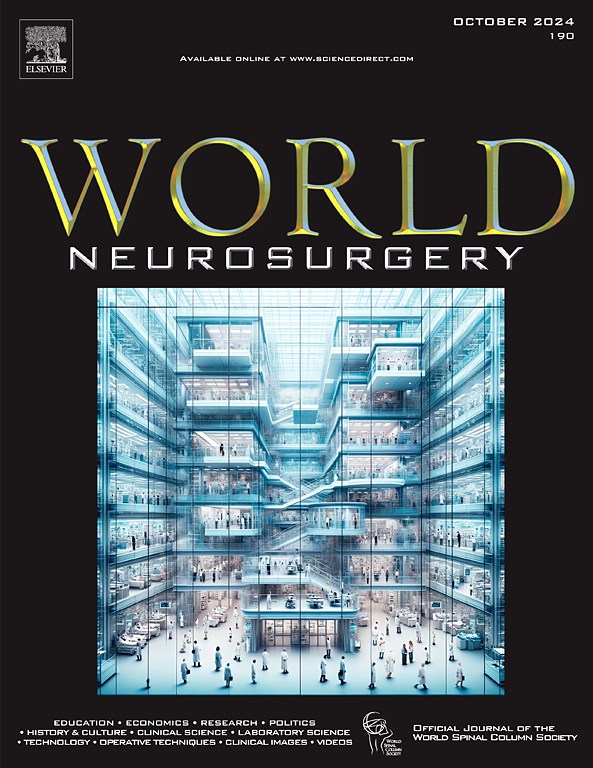颈椎前路减压融合术后脊髓硬膜外血肿的发生率-系统回顾、荟萃分析和病例报告。
IF 2.1
4区 医学
Q3 CLINICAL NEUROLOGY
引用次数: 0
摘要
颈椎前路椎间盘切除术和融合术(ACDF)是一种常用的外科手术,用于治疗椎间盘突出、椎间盘退行性疾病和颈椎神经根压迫。本系统文献综述旨在分析ACDF后脊髓硬膜外血肿(SEH)的发生率、危险因素、临床注意事项和可用治疗方法。方法:按照PRISMA指南,从数据库建立到2025年6月18日,在PubMed、谷歌Scholar和Embase中进行系统检索。这项搜索产生了71项无重复的研究。应用纳入和排除标准后,选择5项研究进行最终分析。结果:ACDF术后SEH总发生率为0.835%。多数患者表现为呼吸困难、截瘫或四肢瘫痪。对5项研究(n = 3246, 28个事件)的荟萃分析证实了这一发生率,且具有中等异质性。治疗方法因症状严重程度、血肿大小和神经功能损害而异。手术减压是最常见的治疗方法,尽管有些病例保守治疗也取得了成功。SEH的发病时间从术后24小时到术后几天不等。结论:虽然不常见,但ACDF后SEH具有显著的临床风险。预防措施可能有助于减轻其发生。然而,有限的文献妨碍了精确确定发病率和相关危险因素,包括凝血功能障碍。显然,需要进行大规模的前瞻性和回顾性研究,并进行标准化的报告,以更准确地定义发生率,识别风险因素,并确定ACDF后SEH的最佳管理。本文章由计算机程序翻译,如有差异,请以英文原文为准。

Incidence of Spinal Epidural Hematoma After Anterior Cervical Decompression and Fusion: Systematic Review, Meta-Analysis, and Case Report
Introduction
Anterior cervical discectomy and fusion (ACDF) is a common surgical procedure used to treat herniated discs, degenerative disc disease, and nerve root compression in the cervical spine. This systematic literature review aims to analyze the available literature on the incidence, risk factors, clinical considerations, and available therapies for spinal epidural hematoma (SEH) following ACDF.
Methods
A systematic search was conducted in PubMed, Google Scholar, and Embase from database inception to June 18, 2025, following the Preferred Reporting Items for Systematic reviews and Meta-Analyses guidelines. The search yielded 71 studies without duplicates. After applying the inclusion and exclusion criteria, 5 studies were selected for the final analysis.
Results
The overall incidence of SEH following ACDF was 0.835%. Most patients presented with dyspnea, paraplegia, or quadriplegia. A meta-analysis of the 5 studies (n = 3246; 28 events) confirmed this incidence, with moderate heterogeneity. Management varied on the basis of symptom severity, hematoma size, and neurological impairment. Surgical decompression was the most common treatment, although some cases were managed conservatively with success. SEH onset ranged from within 24 hours postoperatively to several days after surgery.
Conclusions
Although uncommon, SEH after ACDF carries significant clinical risks. Preventive measures may help mitigate its occurrence. However, the limited literature prevents a precise determination of the incidence and associated risk factors, including coagulation disorders. There is a clear need for large-scale prospective and retrospective studies with standardized reporting to more accurately define the incidence, identify risk factors, and determine the optimal management of SEH following ACDF.
求助全文
通过发布文献求助,成功后即可免费获取论文全文。
去求助
来源期刊

World neurosurgery
CLINICAL NEUROLOGY-SURGERY
CiteScore
3.90
自引率
15.00%
发文量
1765
审稿时长
47 days
期刊介绍:
World Neurosurgery has an open access mirror journal World Neurosurgery: X, sharing the same aims and scope, editorial team, submission system and rigorous peer review.
The journal''s mission is to:
-To provide a first-class international forum and a 2-way conduit for dialogue that is relevant to neurosurgeons and providers who care for neurosurgery patients. The categories of the exchanged information include clinical and basic science, as well as global information that provide social, political, educational, economic, cultural or societal insights and knowledge that are of significance and relevance to worldwide neurosurgery patient care.
-To act as a primary intellectual catalyst for the stimulation of creativity, the creation of new knowledge, and the enhancement of quality neurosurgical care worldwide.
-To provide a forum for communication that enriches the lives of all neurosurgeons and their colleagues; and, in so doing, enriches the lives of their patients.
Topics to be addressed in World Neurosurgery include: EDUCATION, ECONOMICS, RESEARCH, POLITICS, HISTORY, CULTURE, CLINICAL SCIENCE, LABORATORY SCIENCE, TECHNOLOGY, OPERATIVE TECHNIQUES, CLINICAL IMAGES, VIDEOS
 求助内容:
求助内容: 应助结果提醒方式:
应助结果提醒方式:


